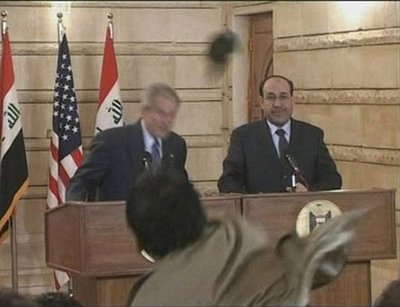June 11, 2009
If the shoe flits, duck: A real-life example of humans’ dual vision system
It’s rare when real-world events perfectly mirror experiments that scientists are conducting.
That’s why neuroscientists at the University of Washington were delighted at the reactions of former President George W. Bush and Iraq’s Prime Minister Nouri al-Maliki when an Iraqi reporter flung his shoes toward the two men during a Baghdad news conference.
When Bush ducked and Maliki didn’t flinch as the first shoe sailed toward them, it was a real-world example supporting the theory that there are two independent pathways in the human visual system.
“The original idea proposed is that one system guides your actions and the other guides your perception. The interesting part is the ‘action’ system allows the brain to ‘see’ things your eyes do not perceive,” said Jeffrey Lin, a UW psychology doctoral student and lead author of a paper appearing June 11 in the journal Current Biology. Co-authors are Scott Murray and Geoffrey Boynton, UW psychology assistant and associate professors, respectively.
“When we throw two balls at you with very similar trajectories, they may look the same to your perceptual system, but your brain can automatically calculate which one is more threatening and trigger a dodging motion before you’ve even realized what has happened,” said Lin.
“If you look at the shoe-throwing video you will see that the prime minister doesn’t flinch at all. His brain has already categorized the shoe as non-threatening which does not require evasive action. But Bush’s brain has categorized the shoe as threatening and triggers an evasive dodge, all within a fraction of a second.”
To explore how this dual visual system works, the researchers set up several experiments that were similar to what baseball players experience when they step into the batter’s box and get ready for the pitcher to throw the ball. In a split second their action system determines if the ball is going to hit their body and whether to initiate a defensive bail out of the batter’s box.
Instead of baseballs, college students participating in three experiments looked at a computer monitor and were instructed to quickly locate a target oval among a field of circular discs, determine its path and press a key when they had found the oval. The key manipulation in the study was that some of the trials began with a looming stimulus at the position of the target oval. When this looming motion was on a collision path with a student’s head, the participant responded faster to the target than when the looming motion just missed the head. The experiment showed that a stimulus on a collision path with a student captured attention but one on a near-miss path did not. Critically, subjects could not differentiate between the subtly different collision and near-miss looming stimuli in a separate experiment.
The authors strongly believe the research supports the idea that the human visual system is composed of two independent systems.
“A major focus of neuroscience is understanding how we deal with sensory information,” said Boynton. “There is no way the brain can possibly process and analyze everything we are exposed to. We have to select what is important. In the real world you are on your own and what you pay attention to is part of survival. This experiment shows that threatening stimuli grab your attention, even those we can’t consciously identify. That this is more accurate than our conscious perception is pretty amazing.”
The research was funded by the National Eye Institute, one of the National Institutes of Health.
###
For more information, contact Lin at 206-616-3899 or jytlin@u.washington.edu; Boynton at 206-685-6493 or gboynton@u.washington.edu; or Murray at 206-543-4532 or somurray@u.washington.edu.

